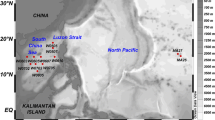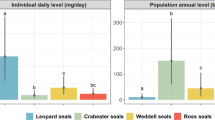Abstract
The role of the Mediterranean euphausiid Meganyctiphanes norvegica in the cycling of radiocerium (141Ce) was examined. When uptake of 141Ce occurs directly from the water, a “dynamic” population equilibrium is reached at a concentration factor of about 250. Molting was responsible for up to 99% loss of total body burden at first molt, and about 45% of the remaining activity at second molt, thus denying true longterm equilibrium to individual animals. Fecal pellets did not contain measureable 141Ce activity when the euphausiids accumulated the isotope from water, thus proving that surface adsorption was the key accumulating process from water. When radiocerium was taken in through ingestion of labelled Artemia, about 99% of the body burden was voided as fecal pellets. Excretion by this route was accelerated when euphausiids were fed non-radioactive Artemia during loss phase. Radioactive counts of the pellets confirmed that all ingested 141Ce was lost through defecation. When 141Ce was ingested as labelled phytoplankton, a substantial fraction of the total body burden occurred in the molts, which indicated that the phytoplankton lost 141Ce to the water and the radioactivity was subsequently adsorbed to outer surfaces of the euphausiids. Molts, fecal pellets, and freshly-killed euphausiids lost 141Ce to the water exponentially, the rates being similar to the exponential portions of the loss curves for live, non-molting individuals. It is suggested that M. norvegica, and probably other pelagic zooplankters, can greatly accelerate radiocerium transport to the ocean floor by packaging the isotope as fecal pellets. In coastal areas subject to low-level radioactive waste disposal, 141Ce might be ionic (or at least soluble) to a great extent, in which case euphausiids could take up the isotope rapidly and accelerate its vertical transport via molting.
Similar content being viewed by others
Literature Cited
Ancellin, J. et A. Vilquin: Contaminations expérimentales d'espèces marines par le cérium 144, le ruthénium 106 et le zirconium 95. In: Disposal of radioactive wastes into seas, oceans and surface waters, pp 583–604, Vienna: IAEA 1966.
——: Nouvelles études de contaminations expérimentales d'espèces marines par le césium 137, le ruthénium 106 et le cérium 144. Radioprotection 3, 185–213 (1968).
Antonini-Kane, J., S. W. Fowler, M. Heyraud, S. Kečkeš, L. F. Small and A. Veglia: Accumulation and loss of selected radionuclides by Meganyctiphanes norvegica M. Sars. Rapp. P.-v. Réun. Commn int. Explor. scient. Mer Méditerr. 21, 289–290 (1972).
Baptist, J. P. and D. E. Hoss: Accumulation and retention of radionuclides by marine fish. Annual Report of the Bureau of Commercial Fisheries Radiobiological Laboratory, Beaufort, N. C., June 30, 1963. Cire. Fish Wildl. Serv., Wash. 204, 14–19 (1965).
Boroughs, H., W. A. Chipman and T. R. Rice: Laboratory experiments on uptake, accumulation and loss of radionuclides by marine organisms. In: The effects of atomic radiations on oceanogrphy and fisheries. pp 80–87. Washington, D. C.: National Academy of Sciences — National Research Council 1957.
Chipman, W. A.: Accumulation of radioactive materials by fishery organisms. Proc. Gulf Caribb. Fish. Inst. 11, 97–110 (1958).
Duursma, E. K.: Geochemical aspects and applications of radionuclides in the sea. Oceanogr. mar. Biol. A. Rev. 10, 137–223 (1972).
Fowler, S. W. and L. F. Small: Sinking rates of euphausiid fecal pellets. Limnol. Oceanogr. 17, 293–296 (1972).
—— and J. M. Dean: Experimental studies on elimination of zinc-65, cesium-137 and cerium-144 by euphausiids. Mar. Biol. 8, 224–231 (1971a).
—— and S. Kečkeš: Effects of temperature and size on molting of euphausiid crustaceans. Mar. Biol. 11, 45–51 (1971b).
Goldberg, E. D., W. S. Broecker, M. G. Gross and K. K. Turekian: Marine chemistry. In: Radioactivity in the marine environment, pp 137–146. Washington, D. C.: National Academy of Sciences 1971.
Greendale, A. E. and N. E. Ballou: Physical state of fission product elements following their vaporization in distilled water and sea water. Ref. USNRLDTR-492 (U.S. Naval Radiological Defense Laboratory, San Franciso) 1954.
Hirano, S., T. Koyanagi and M. Saiki: On the physico-chemical behavior of radioactive cerium in sea water. In: Radioactive contamination of the marine environment, pp 47–55. Vienna: IAEA 1973.
Hiyama, Y. and M. Shimizu: On the concentration factors of radioactive Cs, Sr, Cd, Zn and Ce in marine organisms. Roc. Oceanogr. Wks Japan 7, 43–77 (1964).
Kečkeš, S., S. W. Fowler and L. F. Small: Flux of different forms of 106Ru through a marine zooplankter. Mar. Biol. 13, 94–99 (1972).
Lowman, F. G.: Marine biological investigations at the Eniwetok test site. In: Disposal of radioactive wastes, Vol. 2. pp 105–138. Vienna: IAEA 1960.
—, T. R. Rice and F. A. Richards: Accumulation and redistribution of radionuclides by marine organisms. In: Radioactivity in the marine environment, pp 161–199. Washington, D. C.: National Academiy of Sciences 1971
Mauchline, J. and W. L. Templeton: Artificial and natural radioisotopes in the marine environment. Oceanogr. mar. Biol. A. Rev. 2, 229–279 (1964).
Osterberg, C.: Fallout radionuclides in euphasiids. Science, N.Y. 138, 529–530 (1962).
—, A. G. Carey, Jr. and H. Curl, Jr.: Acceleration of sinking rates of radionuclides in the ocean. Nature, Lond. 200, 1276–1277 (1963a).
—, W. G. Pearey and H. Curl, Jr.: Radioactivity and its relationship to oceanic food chains. J. mar. Res. 22, 2–12 (1964).
—, L. F. Small and L. Hubbard: Radioactivity in large marine plankton as a function of surface area. Nature, Lond. 197, 883–884 (1963b).
Palumbo, R. F.: Factors controlling the distribution of the rare earths in the environment and in living organisms. In: Radioecology, Proceedings of the First National Symposium, pp 533–537. Ed. by V. Schultz and A. W. Klement, Jr.. New York: Reinhold Publ. Corp. 1963.
Polikarpov, G. G.: Radioecology of aquatic organisms, 314 pp. Amsterdam: North Holland 1966.
Rice, T. R., J. P. Baptist, F. A. Cross and T. W. Duke: Potential hazards from radioactive pollution of the estuary. In: Marine pollution and sea life, pp 272–276. Ed. by M. Ruivo (FAO). London: Fishing News (Books) Ltd 1972.
— and V. M. Willis: Uptake, accumulation and loss of radioactive Ce-144 by marine plankton algae. Limnol. Oceanogr. 4, 277–290 (1959).
Slowey, J. F., D. Hayes, B. Dixon and D. W. Hood: Distribution of gamma emitting radonuclides in the Gulf of Mexico. In: Symposium on marine geochemistry, pp 109–129. Ed. by D. R. Shrink and J. T. Corless. Kingston: University of Rhode Island 1965.
Author information
Authors and Affiliations
Additional information
Communicated by J. M. Peres, Marseille
Rights and permissions
About this article
Cite this article
Fowler, S.W., Heyraud, M., Small, L.F. et al. Flux of 141Ce through a euphausiid crustacean. Mar. Biol. 21, 317–325 (1973). https://doi.org/10.1007/BF00381088
Accepted:
Issue Date:
DOI: https://doi.org/10.1007/BF00381088




